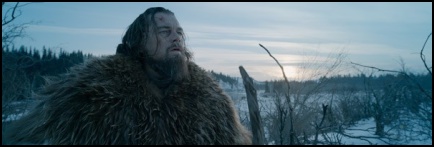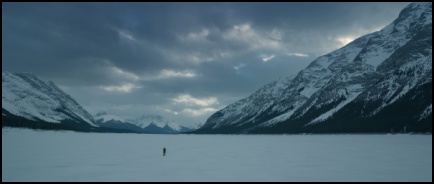The Revenant
Reviewed by Howard DavisA revenant is someone who has returned from the dead. With a running time of 2 hrs and 36 minutes, audiences for Alejandro Inaritu's latest movie might well feel the same way. It's a chilling ordeal to undergo - but nothing compared to what the cast and crew apparently endured. Whether it's worth it or not is obviously the question. Since the movie may well earn diCaprio his long-deserved Oscar and Inaritu his second, the answer is presumably a qualified yes, at least as far as they're concerned ...

Hugh Glass' harrowing narrative is loosely based on his actual 1823 cross-country trek, during which he was mauled by a bear, left for dead, and crawled two hundred miles back to civilization. The story goes that he vowed vengeance on the two men who abandoned him and spent the next several years hunting them down. In fact, he didn't kill either of them and Will Poulter's character, Jim Bridger, later became famous for his own frontier exploits.
While Glass' story
delineated one man's epic struggle to survive against
insurmountable odds, the movie's development and production
were equally tortuous. Development first began in 2001, when
producer Akiva Goldsman acquired the rights to Michael
Punke's unpublished manuscript, with David Rabe writing the
first draft. It stalled until 2010, when Mark L. Smith wrote
a new adaptation of the novel, John Hillcoat was attached to
direct, and Christian Bale was in negotiations for the
staring role. Hillcoat left the project in October, however,
and Inaritu signed on to direct in August 2011.
The
film was further delayed when New Regency Pictures lost its
associated partner. It wasn't until Annapurna Pictures came
on board as a financing associate that pre-production
finally got back on track. Initial camera tests were done on
35mm and 65mm film stock, but a final decision to employ
digital cameras was made because they allowed for an extra
hour of exposure per day. As a result, it's the first
feature film shot to be shot using 6.5k ARRI 65 cameras.
Originally budgeted for an eighty-day shoot, total principal photography ended up taking nine months, due not only to bad weather and the remoteness of the Canadian locations, but also Inaritu's insistence on filming in chronological sequence and using only natural light. Only a few shooting hours were available each day and had to be carefully planned in advance. Unsurprisingly, the shoot went way over schedule and the snow melted before filming was complete. With summer rapidly approaching, the entire production was relocated to the southern tip of Argentina. Inaritu's notoriously temperamental nature, along with the high-pressure schedule and appalling conditions, made it an extremely strenuous shoot and several crew members quit during filming.
The actors also had to endure harsh and
ignominious conditions. The gruesome bear-mauling scene was
filmed with DiCaprio being viciously tugged from side to
side by cables. Despite being a vegetarian, the actor
devoured a raw slab of bison's liver, plunged repeatedly
into sub-zero rivers, and studied with a doctor who
specialized in ancient healing techniques, as well as
learning to shoot a musket, build a fire, and speak both
Pawnee and Arikara.
DiCaprio said that he had seen
Arthur Recloud (Hikuc) eating bison meat on the set all day.
When they gave him a red gelatinous "pancake," it looked so
unrealistic that he decided to try the real thing. He
admitted that he "would never, never do that again" and
described it as the hardest performance of his career.

The stunning primordial landscape never suggests a redeeming or transcendent sense of Nature, but instead provides a remorselessly bleak, primitive, and threatening backdrop. Animals appear to be either vicious and predatory (bears, vultures, wolves), or simply there to be killed, skinned, gutted, and eaten (elk, moose, deer, buffalo, fish, horses). While the white European fur-traders are depicted as uniformly aphasic and atrabilious, at least the suffering of individual Native Americans is presented sympathetically. As a group, however, they are just as barbaric and blood-thirsty as the trappers who are stealing their land.
The sign we see on the hanged Pawnee's body means "We're all savages." In "White Devil: A True Story of War, Savagery And Vengeance in Colonial America," Stephen Brumwell indicates the phrase was first carved into a tree by a Canadian fur trader during the 1680s. In light of recent global events, it's a gruesome message which remains sadly relevant more than three centuries later.



 Martin LeFevre - Meditations: How Deep Does The Human Crisis Go?
Martin LeFevre - Meditations: How Deep Does The Human Crisis Go? Gordon Campbell: On ACT’s Plans To Strip Away The Rights Of Gig Economy Workers
Gordon Campbell: On ACT’s Plans To Strip Away The Rights Of Gig Economy Workers Peter Dunne: Dunne's Weekly - Hipkins' Risky Overseas Trip
Peter Dunne: Dunne's Weekly - Hipkins' Risky Overseas Trip Binoy Kampmark: Peter Doherty - Public Science Communicator
Binoy Kampmark: Peter Doherty - Public Science Communicator Binoy Kampmark: Beyond Irritation - Bali’s Tourism Scourge
Binoy Kampmark: Beyond Irritation - Bali’s Tourism Scourge Martin LeFevre - Meditations: Sunday Morning In California As The Season Changes
Martin LeFevre - Meditations: Sunday Morning In California As The Season Changes